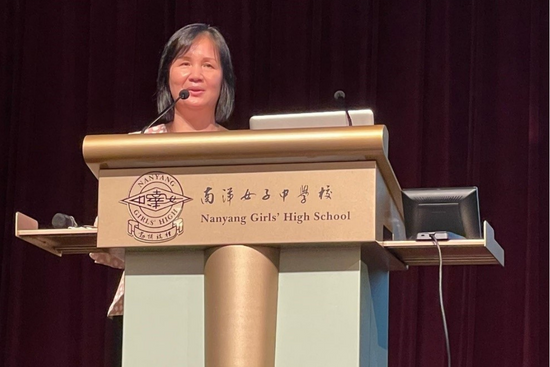On 5 September, Dr Susan Xu, SUSS Head of Translation and Interpretation, was invited to give a two-hour talk to 150 students from Nanyang Girl’s High School at their “Translation Camp” titled “新加坡本土特色翻译: 中西合璧 雅俗共赏” (Contextualising translation in Singapore where the East meets the West to produce the Best).

Dr Susan Xu, SUSS Head of Translation and Interpretation, addressing the students at Nanyang Girl’s High School.During her talk, Dr Xu guided students in evaluating the translations of cultural-specific expressions arising from “uniquely Singapore” phenomena such as “chope a seat” (霸位), “HDB Flat” (组屋) and “The Istana” (总统府). Some bilingual expressions aptly adapt to the evolving social norms such as “senior citizens” (乐龄 instead of 老年人)and “migrant worker” (客工 instead of 外劳). However, there are a handful that may need better translations in order to convey their significance. For instance, the transliteration of “Vesak Day” (卫塞节) could lose its Buddhism appeal, and a free translation “浴佛节” could be more meaningful.
Students also learnt to distinguish between high and low context culture as well as between polychronic and monochronic culture. Through contextualising similar phenomena such as public housing, ageing population, festivals in different cultures, students gained an understanding of how different translations best suit specific contexts.
Overall, it was a fruitful session for the students in understanding the cultural nuances and differences between the East and West. Singapore, a global city where the East meets the West, offers a fertile ground for students to deepen their understanding of cultural differences and hone their bilingual and translation skills.
Learn more about the SUSS Translation and Interpretation programme to develop professional skills in translation and interpretation.